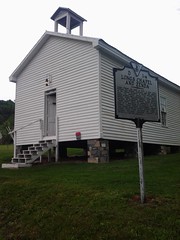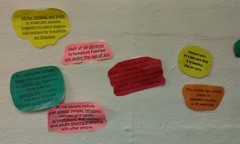How could we have lived in this valley for 20 years and not know about places like Zenda, Long’s Chapel, Newtown, or the stories of Lucy Simms, Bethel A.M.E. church, Ralph Sampson or the Islamic Center of the Shenandoah Valley? Here they all were, right under our noses and yet we were not familiar with these people, these places and their stories. Could it be that this history is not considered “mainstream” or as significant to the valley as other narratives?
We want to make sure everyone in the valley knows what we now know. Here are some excerpts from students’ journals as they have reflected on their month long study of the Shenandoah Valley and a quick three day trip to Washington, D.C.
“The most shocking thing I heard about Newtown (historic African American community north of current northeast neighborhood) was about the revitalization project called Project R4. The fact that the city (Harrisonburg) took parts of the neighborhood under public domain and turned it into retail space is tragic. If the city would have taken the parts it did and helped turn the neighborhood into a better area to live it would have been a great thing.”
-David Gauldin
 “Rockingham County was unlike the large slaveholding counties in other parts of Virginia. There were many religious groups (including the Mennonites, Dunkers, Methodists, Brethren and others that opposed the institution of slavery.” (Freedom’s Child, pg. 18) Because of this free blacks were able to purchase small plots of land and establish a settlement called “Zenda.”
“Rockingham County was unlike the large slaveholding counties in other parts of Virginia. There were many religious groups (including the Mennonites, Dunkers, Methodists, Brethren and others that opposed the institution of slavery.” (Freedom’s Child, pg. 18) Because of this free blacks were able to purchase small plots of land and establish a settlement called “Zenda.”
In the heart of the Shenandoah Valley lies a single remnant of Zenda, a settlement formed after the Civil War by newly freed slaves. When Rockingham Country reclaimed the property from a former plantation owner in a postwar legal action, they decided to sell it to the freedmen. Thus Zenda, known as ‘Little Africa’ was born. The church, Long’s Chapel, served not only as the spiritual center of the community, but as the educational center as well. Since the county did not provide for the education of black students, this facility became the first school for the community residents. In 2005, Alfred and Robin Jenkins purchased the property in order to preserve and restore it, in hopes of establishing a black history heritage site. Long’s Chapel at Zenda is now on the National Register of Historic Places. Zenda is an historical landmark that symbolizes freedom and the end of slavery for African Americans here in the valley.
Lucy Simms’s career in public education spanned 56 years, with only one half-day lost due to illness. This level of courage, commitment and care is so admirable!
My journey on this cross cultural has changed my way of thinking of both the life that I have and the lives of immigrants that this great nation is built upon. I will no longer take for granted the life that I have been given, nor the influence I may have in helping someone make their life better. I also have a greater appreciation for undocumented immigrants that have come to the U.S. seeking a better life for themselves.
-Michael Wade
In D.C. we saw a guy carrying a WHOLE gutted, scalded pig through the streets of D.C. on his shoulder, right into the front doors of a restaurant. (Guess what we’re having for lunch?)
-Belinda Hinkle
The Brethren Mennonite Heritage Center was my favorite place. Just learning about how this lady was such a feminist back in the day was really empowering. The house and the rest of the land were awesome to tour and learn about. I wish I could have been around to go to one of the tent revivals with George Brunk. They looked like they would have been a lot of fun.
-Jess Biggs
Journal entry after watching TedTalks, The Danger of the Single Story
I was struck by how important it is for each of us to not only be aware of the dangers of pigeon-holing people and groups into a single “story” that defines them, but also most importantly I was struck by our personal responsibility to seek out more than the “single story” of the people we meet and the communities we encounter.
the dangers of pigeon-holing people and groups into a single “story” that defines them, but also most importantly I was struck by our personal responsibility to seek out more than the “single story” of the people we meet and the communities we encounter.
-Katie Gray